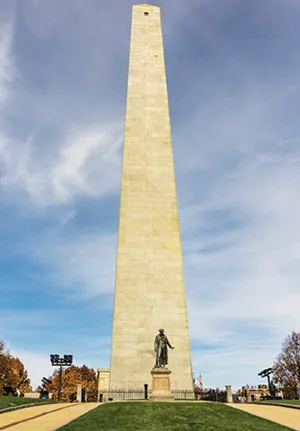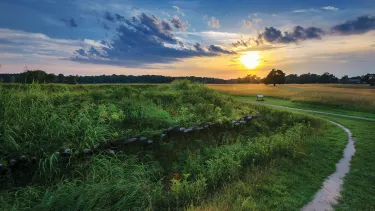
Bunker Hill Monument, Charlestown, Mass.
The first Revolutionary War preservation efforts began before the war even ended. Congress authorized a monument commemorating the victory at Yorktown in 1781. Private preservation efforts began shortly after the War of 1812, with wealthy citizens purchasing land at sites like Fort Ticonderoga and Bunker Hill. At Bunker Hill, the Bunker Hill Monument Association, which included prominent citizens like Daniel Webster, initially purchased fifteen acres of Breeds Hill with plans to place a monument atop it. The Marquis de Lafayette laid the cornerstone during his 1825 tour of the United States, and Rev. Joseph Thaxter, who was wounded at the battle, acted as Chaplain for the ceremonies. Unfortunately, the costs of the monument forced the association to sell ten acres of the battlefield to fund its construction, a fitting allegory for early battlefield preservation efforts.

In 1836 the State of Indiana purchased 16 acres of the Tippecanoe battlefield, the first public preservation of a battlefield in United States history. Following the Civil War, in 1875, the site of the Battle of Mackinac Island became the second National Park and first nationally protected battlefield. Mackinac Island may seem a strange place for battlefield preservation given its minor significance in the War of 1812; ironically it was preserved more because of its natural beauty and popularity as a vacation destination than because of the battlefield.
The 1876 Centennial renewed public interest in the nation’s formative wars and helped to heal the wounds of the fractured nation by focusing on its united past. The late 19th and early 20th century approach to battlefield preservation was the “Antietam Approach,” focusing on narrow strips of land where monuments could be placed and avoiding the costly process of acquiring large tracts of land. The fundamental flaw with this plan was its reliance on rural battlefields to remain rural, an assumption that has proved categorically false in the last century, putting battlefields at great risk of being lost.

In 1925 the War Department began to focus on preserving Revolutionary War sites in a similar way to the National Military Parks established at Chickamauga and Chattanooga, Shiloh, Vicksburg, Antietam, and Gettysburg. In the 1930s, National Historic Parks began to be created at sites like Yorktown, Saratoga, and Morristown. At the same time many private efforts were directed at preserving individual houses and structures related to the early wars. Many of these still remain, providing a rich supplement to preserved historical spaces.
The 1976 Bicentennial saw a flourish of historical interest, study, and preservation, however, no national system was established and key sites were overlooked. The National Register of Historic Places grew exponentially during this time, however, which facilitated private, local, state, and national preservation efforts, particularly for historic structures, but lacked the focus and strength for national battlefield preservation. In the early 2000s, renewed interest in Revolutionary War and War of 1812 battlefield preservation reached the national level, with an official detailed National Park Service report appearing in 2007. Based on this, the National Park Service approached the Civil War Trust in 2013 to expand its battlefield preservation efforts to Revolutionary War and War of 1812 sites. Campaign 1776 was born.





